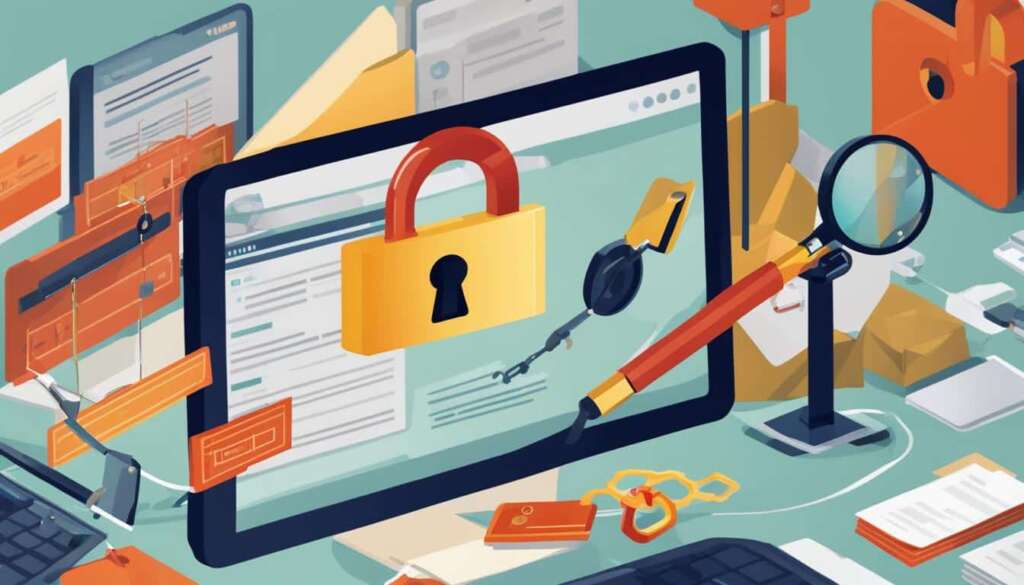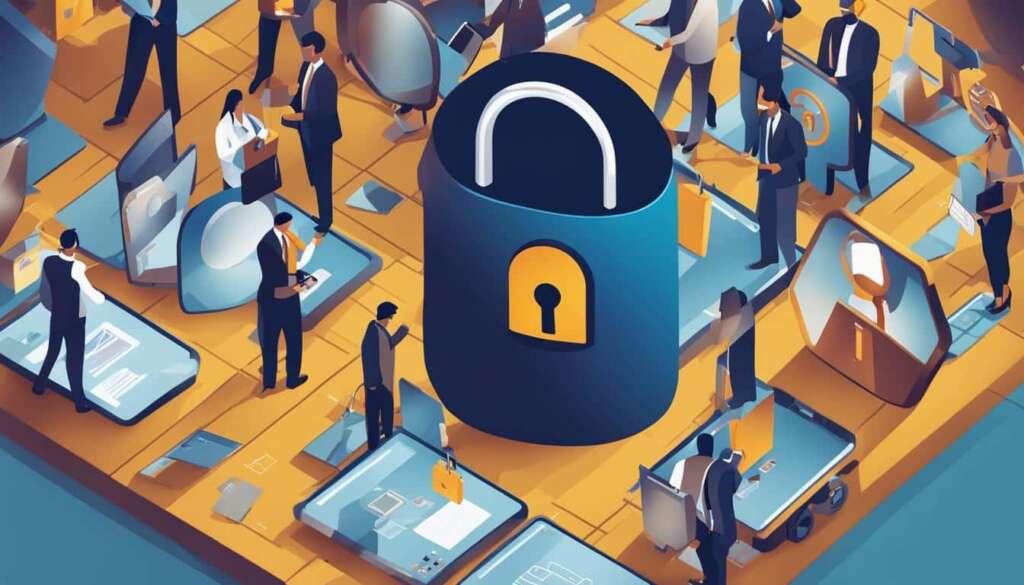Table of Contents
Cybersecurity awareness and training play a vital role in protecting organizations from online threats and ensuring the security of sensitive data. With the increasing prevalence of cyberattacks and data breaches, it has become imperative for businesses to prioritize cybersecurity education for their employees.
Effective cybersecurity training equips individuals with the knowledge and skills to identify and mitigate potential risks, such as phishing attacks, compromised credentials, and internal leaks. By raising awareness and promoting a culture of security, organizations can empower their workforce to navigate the digital landscape confidently and responsibly.
In this article, we will explore the importance of cybersecurity education, define the risks organizations face, and discuss strategies for implementing a successful cybersecurity training program. Furthermore, we will delve into the role of “security champions,” the benefits of partnering with HR, and the significance of National Cyber Security Awareness Month.
Join us as we explore the key elements of an effective cybersecurity training program and discover how organizations can foster a culture of security in an ever-evolving digital world.
The Importance of Education in Cybersecurity
Educating individuals on cybersecurity is vital in today’s digital age. With the increase in cyber threats and the potential for severe consequences, organizations must prioritize cybersecurity education to mitigate risks effectively. Cybersecurity education equips individuals with the knowledge and skills necessary to identify and respond to cyber threats, minimizing the likelihood of successful attacks.
Cyber education encompasses a range of activities, including cybersecurity workshops, cybersecurity courses, and ongoing training programs. These initiatives help users understand the value of their information and the potential risks associated with cyber threats. By raising awareness about the dangers of internal leaks and the prevalence of phishing attacks, organizations can empower individuals to become assets rather than vulnerabilities in the fight against cybercrime.
An effective cybersecurity education program should cover various topics, including password security, social engineering, data protection, and incident response. By providing comprehensive training on these subjects, organizations can ensure that employees possess the necessary skills to protect sensitive information and respond appropriately to potential cyber threats.
“Cybersecurity education is the key to building a resilient workforce that can defend against evolving cyber threats. By investing in the development of cybersecurity skills and knowledge, organizations can strengthen their security posture and safeguard their critical assets.” – Cybersecurity Expert
Benefits of Cybersecurity Education:
- Increased awareness of cyber threats and their potential impact
- Enhanced ability to identify and respond to phishing attacks
- Reduced risk of internal data leaks
- Improved overall cybersecurity posture
- Empowered employees who actively contribute to the organization’s security efforts
| Cybersecurity Workshops | Cybersecurity Courses | Ongoing Training Programs | |
|---|---|---|---|
| Format | In-person or virtual workshops | Online or classroom-based courses | Regular sessions or modules |
| Focus | Interactive sessions to raise awareness and develop practical skills | In-depth study of cybersecurity principles, techniques, and best practices | Continuous learning and reinforcement of cybersecurity knowledge |
| Target Audience | All employees, tailored to specific roles and responsibilities | Technical and non-technical individuals interested in cybersecurity | All employees, including periodic refresher sessions |
| Key Benefits | Engaging and interactive learning experience | Comprehensive understanding of cybersecurity concepts | Ongoing knowledge updates and reinforcement |
Investing in cybersecurity education is a strategic decision that can yield valuable returns in terms of strengthened security measures and reduced risk of cyber threats. By equipping employees with the necessary knowledge and skills, organizations can foster a culture of cybersecurity and empower their workforce to remain vigilant against potential cyber attacks.
Defining the Risks
When it comes to cybersecurity, understanding the risks is essential. Organizations face numerous threats, including data breaches, compromised credentials, internal leaks, and phishing attacks. By analyzing these risks, organizations can develop effective strategies to mitigate them and protect their valuable information.
Data Breaches
Data breaches are a significant concern for organizations across industries. These breaches occur when unauthorized individuals gain access to sensitive data, resulting in financial losses, reputational damage, and legal consequences. According to recent studies, data breaches are primarily caused by compromised credentials, accounting for 20% of reported incidents. This highlights the importance of implementing robust password policies, multi-factor authentication, and regular account audits to prevent unauthorized access and protect sensitive data.
Compromised Credentials
Compromised credentials serve as a common entryway for cybercriminals, enabling them to gain unauthorized access to systems and networks. This can occur through various methods such as phishing attacks, where hackers deceive individuals into revealing their login credentials. Organizations must educate their employees about the risks of phishing attacks, emphasizing the importance of vigilance, skepticism, and verifying the legitimacy of requests before sharing sensitive information.
Internal Leaks
While external threats often make headlines, organizations should not overlook the risks posed by internal leaks. Internal leaks can occur due to human error, negligence, or malicious intent. Employees may inadvertently share sensitive information through email, cloud storage, or other digital platforms, potentially compromising the organization’s security. Regular cybersecurity awareness training can help employees understand their responsibilities in safeguarding sensitive information and reduce the likelihood of internal leaks.
Phishing Attacks
Phishing attacks remain a significant threat to organizations of all sizes. These attacks involve tricking individuals into providing personal information, such as login credentials or financial details. Phishing attacks often target employees through emails, instant messages, or fraudulent websites. By raising awareness about the telltale signs of phishing attempts and providing guidance on safe online practices, organizations can empower their employees to identify and report phishing attacks, enhancing overall cybersecurity.
Understanding the risks that organizations face is the first step towards building effective cybersecurity strategies. By addressing data breaches, compromised credentials, internal leaks, and phishing attacks, organizations can better protect their valuable information and maintain a secure environment. Ongoing education, regular updates to training materials, and the implementation of robust security measures are essential in mitigating these risks and ensuring the overall cybersecurity of the organization.
Strategies for an Effective Cybersecurity Training Program
Cybersecurity training is a crucial aspect of implementing a comprehensive information security education program. To ensure the ongoing protection of sensitive data and systems, organizations must develop and implement strategies that promote continuous learning and awareness among employees. Here are some key strategies for creating an effective cybersecurity training program:
1. Annual Security Training for All Employees
In order to create a culture of security, it is essential to provide annual security training to all employees, both technical and non-technical. This ensures that everyone in the organization understands the importance of cybersecurity and is aware of their role in maintaining a secure environment. The training should cover topics such as identifying phishing attacks, safe browsing habits, and best practices for password management.
2. Partnering with the Communications Team
Incorporating the expertise of the communications team can enhance the effectiveness of cybersecurity training materials. By collaborating with the communications team, organizations can create engaging and visually appealing training content that effectively conveys key security concepts. This partnership ensures that the training materials are not only informative but also engaging and memorable.
3. Practical Exercises and Demonstrations
The use of practical exercises and demonstrations can help reinforce key cybersecurity concepts. By providing hands-on training opportunities, employees can actively engage with the material and gain a deeper understanding of how to apply security practices in real-world scenarios. These exercises can include simulated phishing campaigns, incident response drills, and interactive workshops.
| Benefits of an Effective Cybersecurity Training Program | Key Strategies |
|---|---|
| Improved awareness of security risks | Annual security training for all employees |
| Reduced likelihood of human error leading to breaches | Partnering with the communications team |
| Enhanced response to security incidents | Practical exercises and demonstrations |
By implementing these strategies, organizations can create a robust cybersecurity training program that fosters a culture of security throughout the company. Ongoing education and awareness are critical in keeping up with the ever-evolving threat landscape, and a well-trained workforce is an essential defense against cyber threats.
The Role of Security Champions
Enlisting passionate individuals across the organization to champion security and raise awareness can significantly contribute to the success of a cybersecurity training program. These “security champions” play a crucial role in modeling best practices, supporting infosec events and campaigns, and receiving regular training to stay updated.
Security champions act as role models within their respective teams, promoting a culture of security excellence. By demonstrating proper security protocols and highlighting the importance of cybersecurity, they inspire their colleagues to adopt similar behaviors and attitudes towards information security. Their influence extends beyond individual teams, fostering a collective commitment to safeguarding sensitive data and mitigating cyber risks.
Security champions are not only responsible for their own adherence to cybersecurity protocols but also for encouraging their peers and colleagues to do the same. Their involvement in training sessions and workshops helps to foster a sense of shared responsibility and accountability, creating a stronger defense against potential threats.
Raising awareness is a key objective of security champions. They actively engage with employees, organizing information sessions, and disseminating relevant resources. By highlighting the latest cybersecurity trends and providing practical tips, they empower individuals at all levels of the organization to make informed decisions and take proactive measures to protect sensitive information.

Benefits of Security Champions
- Improved awareness and knowledge of cybersecurity best practices
- Increased overall security posture of the organization
- Enhanced employee engagement and motivation
- Reduced risk of security breaches
- Establishment of a robust security culture
By cultivating security champions, organizations can tap into the collective power of their workforce to bolster their cybersecurity defenses. These individuals serve as advocates, educators, and mentors, fostering a culture of security awareness and responsibility. Their dedication and commitment to modeling best practices contribute to a more secure digital environment for the entire organization.
National Cyber Security Awareness Month
October is a significant month for cybersecurity awareness and education. National Cyber Security Awareness Month (NCSAM) provides organizations with an opportunity to promote best practices and enhance their cybersecurity training programs.
During NCSAM, organizations can run engaging cybersecurity campaigns that raise awareness among employees and promote a culture of security throughout the year. This month-long campaign offers a platform to share resources, educational materials, and information about the latest cyber threats and preventive measures.
“NCSAM is a valuable initiative that allows organizations to engage their employees in cybersecurity awareness and education,” says Sarah Johnson, a cybersecurity expert. “By participating in NCSAM, organizations can empower their employees to become the first line of defense against cyber threats.”
Engaging Activities for NCSAM
During NCSAM, organizations can organize various activities to engage employees and promote cybersecurity awareness. Here are some ideas:
- Run contests or quizzes related to cybersecurity best practices, rewarding participants with small incentives.
- Create informative posters or infographics highlighting key cybersecurity tips and display them in common areas.
- Share relevant articles, videos, and resources on the company intranet or through internal communication channels.
Organizations can also invite guest speakers or conduct workshops on cybersecurity topics during NCSAM. This allows employees to learn from industry experts and gain insights into the latest trends and threats in the cyber landscape.
Benefits of NCSAM Participation
Participating in NCSAM can bring several benefits to organizations:
- Increased awareness: NCSAM helps organizations raise awareness about cybersecurity and the importance of safe online practices.
- Better preparedness: By engaging employees in cybersecurity discussions and activities, organizations can improve their overall preparedness against cyber threats.
- Enhanced culture of security: NCSAM reinforces the importance of a security-focused culture within the organization, encouraging employees to prioritize cybersecurity in their daily activities.
By leveraging NCSAM, organizations can strengthen their cybersecurity training programs and foster a resilient workforce that is well-equipped to defend against cyber threats.
| Benefits of NCSAM Participation | Explanation |
|---|---|
| Increased awareness | NCSAM raises awareness about cybersecurity and safe online practices among employees. |
| Better preparedness | Engaging employees in cybersecurity discussions and activities improves overall preparedness against cyber threats. |
| Enhanced culture of security | NCSAM reinforces the importance of a security-focused culture within the organization. |
Guest Speakers and External Expertise
Bringing in cybersecurity experts as guest speakers can significantly enhance the effectiveness of your cybersecurity training program. These external speakers can provide unique perspectives and insights, drawing from their vast experience in the field. They can share real-world examples, case studies, and practical tips that can help your employees better understand the importance of cybersecurity and the potential risks they may face.
Organizing live events or town halls with guest speakers creates an engaging learning environment, allowing employees to interact and ask questions. In addition to live events, videos featuring external experts can be a valuable resource. They can be used to deliver informative and engaging training sessions that can be accessed by employees at their convenience.
By bringing in industry experts, you are able to tap into their knowledge and experience, providing your employees with valuable insights and practical advice to enhance their cybersecurity awareness and skills.
Furthermore, guest speakers can also help raise awareness and create a sense of urgency around cybersecurity. Their presence sends a strong message about the importance of cybersecurity and the organization’s commitment to protecting sensitive information. It can inspire employees to take security seriously and motivate them to adopt best practices in their daily work.
Benefits of Guest Speakers and External Expertise:
- Unique perspectives and insights
- Real-world examples and case studies
- Practical tips to enhance cybersecurity skills
- Engaging learning environment
- Opportunity for interaction and Q&A
- Raising awareness and creating a sense of urgency

| Benefits of Guest Speakers | External Expertise |
|---|---|
| Unique perspectives and insights | In-depth knowledge and experience |
| Real-world examples and case studies | Practical tips and advice |
| Engaging learning environment | Interactive sessions and Q&A |
| Raising awareness and creating a sense of urgency | Motivating employees to prioritize cybersecurity |
Partnering with HR for a Culture of Security
Creating a culture of security within an organization requires a collaborative effort from various departments, and HR plays a crucial role in fostering this culture. By partnering with HR, organizations can ensure that security becomes an integral part of the employee experience, promoting awareness, education, and support.
One way HR can contribute to building a culture of security is by incorporating information security into position descriptions and onboarding processes. By clearly articulating the importance of security in job roles, organizations can set expectations from the start and ensure that employees understand their responsibility in safeguarding sensitive information.
Additionally, HR can play a vital role in providing regular training schedules for employees. By making security training a mandatory part of ongoing professional development, organizations can ensure that employees are continually updated on the latest security threats and best practices.
Promoting Employee Support and Engagement
HR can also help create an environment where employees feel supported in their security efforts. By establishing channels for employees to ask questions and seek clarification on security protocols, HR can alleviate any concerns or uncertainties that may arise. Regular communication and reminders about security practices can also be facilitated by HR, reinforcing the importance of security in day-to-day operations.
Furthermore, HR can collaborate with the IT department to implement employee recognition programs that reward individuals for exemplifying strong security practices. Recognizing and encouraging positive behavior can not only motivate employees to adhere to security protocols but also create a sense of collective responsibility and accountability.
Maintenance and Updates of Training Materials
Regularly updating training materials is crucial to keep pace with the evolving threat landscape and ensure the ongoing effectiveness of cybersecurity awareness training. As new tactics and vulnerabilities emerge, organizations must continuously improve their training strategies to address knowledge gaps and equip employees with the necessary skills to prevent and respond to cyber threats.
To achieve this, training updates should be conducted on a regular basis, ideally annually or as needed. These updates should encompass a range of elements, including new cybersecurity best practices, emerging threats, and the latest technologies and tools for protection.
Continuous improvement in training materials is essential to provide employees with up-to-date knowledge and equip them with the skills to identify and mitigate potential risks. By keeping training materials current, organizations can ensure their workforce remains informed and proactive in safeguarding critical information and systems.
“Regularly updating training materials is crucial to keep pace with the evolving threat landscape and ensure the ongoing effectiveness of cybersecurity awareness training.”
The Benefits of Continuous Training Updates
There are several key benefits to maintaining and updating training materials on an ongoing basis. First and foremost, it allows organizations to stay ahead of emerging threats and vulnerabilities, ensuring their employees are well-prepared to counter potential cyberattacks. By incorporating the latest information and techniques into training materials, organizations can better equip their workforce to identify and respond to new and evolving threats.
Furthermore, updating training materials provides an opportunity to incorporate feedback from simulations and exercises. This allows organizations to identify areas for improvement and fine-tune their training strategies based on real-world scenarios. By leveraging this feedback loop, organizations can continuously enhance the effectiveness of their cybersecurity awareness training program.
Ensuring Training Effectiveness
To measure the effectiveness of training updates, organizations can track key performance metrics such as the reduction in successful phishing attempts, the number of reported incidents, and employee feedback. These metrics can help gauge the impact of the training program and identify areas where further improvements may be needed.
Additionally, organizations can conduct periodic assessments or quizzes to evaluate employees’ knowledge and understanding of the updated training materials. These assessments can help identify any gaps in knowledge and provide targeted training or resources to address them.
By prioritizing regular maintenance and updates of training materials, organizations can ensure their cybersecurity awareness training remains relevant, effective, and aligned with the evolving threat landscape. This ongoing commitment to training will help build a security-conscious culture and empower employees to be proactive in protecting sensitive information and systems.

Measuring Effectiveness with Phishing Simulations
Measuring the effectiveness of cybersecurity awareness training is crucial in ensuring that employees are equipped to detect and respond to phishing attacks. Traditional post-training quizzes may not provide accurate insights into user awareness and preparedness. This is where phishing simulations can play a significant role in evaluating the effectiveness of training programs.
Phishing simulations involve sending realistic phishing emails to employees and measuring their response. By analyzing how users interact with these simulated attacks, organizations can identify areas of vulnerability and prioritize further training. The simulations can assess user awareness, response rates, and susceptibility to social engineering tactics.
Results from phishing simulations can provide valuable metrics that quantify the level of user awareness and preparedness. This data can be used to address knowledge gaps, tailor training materials, and improve overall cybersecurity strategies. Effective simulations can help organizations create a proactive security culture, where employees remain vigilant against potential threats.
Implementing regular phishing simulations as part of a comprehensive cybersecurity training program ensures that employees are not only educated but also capable of applying their knowledge in real-world scenarios. By continuously assessing user awareness and providing targeted training, organizations can significantly enhance their cybersecurity defenses.

Table: Key Metrics for Phishing Simulations
| Metric | Description |
|---|---|
| Click-through Rate | The percentage of users who click on a simulated phishing link. |
| Report Rate | The percentage of users who report a simulated phishing email. |
| Conversion Rate | The percentage of users who enter their credentials on a simulated phishing page. |
| Time to Response | The average time taken by users to respond to a simulated phishing email. |
| Training Effectiveness | The improvement in user response rates after completing cybersecurity awareness training. |
The Importance of Trust in Cybersecurity
Trust is a fundamental element in the realm of cybersecurity. It is not only about trusting the technology that protects our sensitive data but also about having trust within our teams and colleagues. Just as successful sports teams rely on trust among players to achieve their goals, cybersecurity teams must have trust in their computers and teammates to effectively combat cyber threats.
Building trust in cybersecurity starts with emphasizing reliable and repeatable behavior. This means consistently following best practices, adhering to security protocols, and demonstrating a commitment to maintaining a secure environment. By establishing a culture of trust, organizations can instill confidence in their employees, promoting responsible cybersecurity practices across the board.
Trust in cybersecurity extends beyond individuals to the technology itself. Having reliable systems and infrastructure is crucial in safeguarding sensitive information. Organizations must invest in robust cybersecurity measures to build trust in their technology and ensure the integrity and confidentiality of data.
“Trust is the glue of life. It’s the most essential ingredient in effective communication. It’s the foundational principle that holds all relationships.”
In the complex landscape of cybersecurity, trust is a key element that underpins the success of any security strategy. By fostering trust in both technology and teams, organizations can enhance their resilience against cyber threats and build a solid foundation for a secure future.
The Importance of Trust in Cybersecurity
| Key Points | Benefits |
|---|---|
| Emphasize reliable and repeatable behavior | Builds confidence in individuals and teams |
| Invest in robust cybersecurity measures | Ensures the integrity and confidentiality of data |
| Foster trust in technology and teams | Enhances resilience against cyber threats |
Conclusion
Cybersecurity awareness training plays a critical role in safeguarding organizations against the ever-evolving cyber threats of the future. By prioritizing ongoing education and implementing effective training strategies, organizations can empower their employees to navigate the complex landscape of cybersecurity with confidence.
Throughout this article, we have highlighted the importance of education in cybersecurity, defined the risks that organizations face, and discussed strategies for developing an effective cybersecurity training program. We have also explored the role of “security champions” and the benefits of partnering with HR to foster a culture of security.
To stay ahead in the cybersecurity realm, organizations must continuously maintain and update their training materials to ensure their relevance and effectiveness. By measuring the impact of training through phishing simulations, organizations can identify knowledge gaps and refine their training strategies accordingly.
Building trust is another key aspect of cybersecurity. Trust in technology and among team members is essential for effective responses to cyber threats. By emphasizing reliable and repeatable behavior, organizations can instill confidence in individuals and teams.
In conclusion, cybersecurity awareness training is not a one-time event but an ongoing process that requires continuous improvement. By investing in education, implementing effective strategies, and fostering a culture of security, organizations can protect themselves against cyber threats and ensure a secure future.
FAQ
How often should cybersecurity training be conducted?
Cybersecurity training should be conducted annually for all employees, both IT staff and non-technical personnel.
What should be included in a cybersecurity training program?
A comprehensive cybersecurity training program should cover topics such as the value of personal information, the dangers of internal leaks, the threat of phishing attacks, and best practices for online security.
How can organizations enhance the effectiveness of training materials?
Organizations can partner with their communications team to create engaging messaging, utilize practical exercises and demonstrations, and bring in guest speakers from well-known organizations.
How can HR contribute to a culture of security?
HR can incorporate information security into position descriptions, onboarding processes, and regular training schedules. They can also create an environment where employees feel comfortable asking questions and prioritizing security in their work.
How often should training materials be updated?
Training materials should be regularly updated to keep content fresh and relevant. As the threat landscape evolves, new training topics and methods may be required.
How can the effectiveness of cybersecurity awareness training be measured?
Phishing simulations can provide insightful metrics by evaluating user awareness and response to realistic scenarios. Results can be used to address knowledge gaps and improve training strategies.
Why is trust important in cybersecurity?
Trust is essential in cybersecurity, both in technology and in teams. Building trust through reliable and repeatable behavior allows individuals and teams to respond effectively to cyber threats.
What is the goal of cybersecurity awareness training?
The goal of cybersecurity awareness training is to empower employees to navigate the evolving landscape of cybersecurity with confidence, mitigating risks and safeguarding organizations against cyber threats.
Source Links
- https://www.ellucian.com/blog/cybersecurity-training-higher-education-8-tips-effective-strategy
- https://hbr.org/2023/05/building-an-effective-cybersecurity-training-program
- https://www.techtarget.com/searchsecurity/tip/Cybersecurity-employee-training-How-to-build-a-solid-plan













